FIRST® Training Media
Inspectable Roundsling Removal Criteria
- 1. Missing Identification
- 2. Acid or Caustic Burns
- 3. Evidence of Heat Damage
- 4. Punctures and Holes
- 5. Cuts and Tears
- 6. Abrasive Wear
- 7. Broken or Damaged Core Yarns
- 8. Weld Splatter
- 9. Knotted
- 10. Fitting Damage
- 11. Illegible Identification
- 12. Impacted Particles
- 13. Other Conditions
- 1. Missing Identification
-
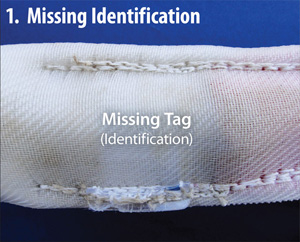 The
sling identification must contain the manufacturer’s name or trademark,
code or stock number, rated load for the type of hitch used and angle
upon which it is based, core material and cover material if different,
and number of legs if more than one.
The
sling identification must contain the manufacturer’s name or trademark,
code or stock number, rated load for the type of hitch used and angle
upon which it is based, core material and cover material if different,
and number of legs if more than one.
- 2. Acid or Caustic Burns
-
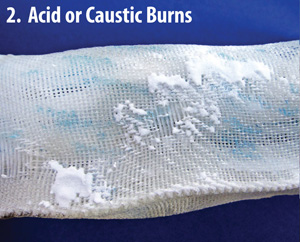 Cover or core yarn material degraded by chemicals.
Cover or core yarn material degraded by chemicals.
- 3. Evidence of Heat Damage
-
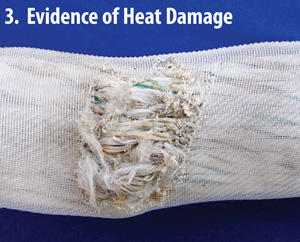 Material damage due to high heat exposure, such as furnace, flame, or
loads whose temperatures exceed – for polyester slings,194°F; 90°C – or
for high performance/HP yarns, 158°F, 70°C.
Material damage due to high heat exposure, such as furnace, flame, or
loads whose temperatures exceed – for polyester slings,194°F; 90°C – or
for high performance/HP yarns, 158°F, 70°C.
- 4. Punctures and Holes
-
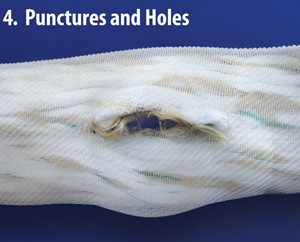 Cover separation that exposes core yarns and often passes completely through the sling body
Cover separation that exposes core yarns and often passes completely through the sling body
- 5. Cuts and Tears
-
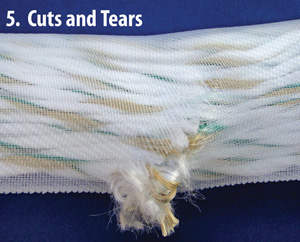 Lacerated or torn areas in the cover that create a breach, exposing the core yarns.
Lacerated or torn areas in the cover that create a breach, exposing the core yarns.
- 6. Abrasive Wear
-
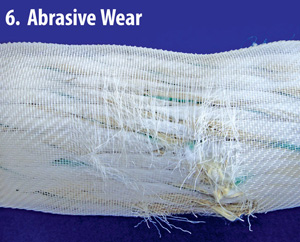 Surface scrubbing of the cover. Rejection of the sling is required due
to a breach in the cover which exposes core yarns to the surface and/or
associated heat damage.
Surface scrubbing of the cover. Rejection of the sling is required due
to a breach in the cover which exposes core yarns to the surface and/or
associated heat damage.
- 7. Broken or Damaged Core Yarns
-
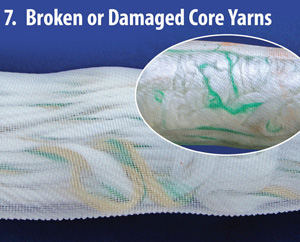 Core yarn that is noticeably separated across its axis. The yarn typically recoils resulting in a backlash.
Core yarn that is noticeably separated across its axis. The yarn typically recoils resulting in a backlash.
- 8. Weld Splatter
-
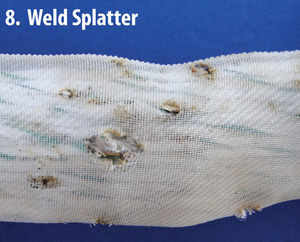 Hot droplets of weld slag burns the cover and core yarns.
Hot droplets of weld slag burns the cover and core yarns.
- 9. Knotted
-
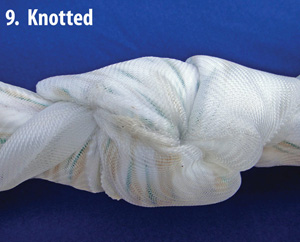 A fused, seated and/or non-removable knot, which encompasses the sling
body (not to be confused with the internal core “knot” this is the core
yarn termination and will be taped. Also, the tail ends of the internal
termination will be taped).
A fused, seated and/or non-removable knot, which encompasses the sling
body (not to be confused with the internal core “knot” this is the core
yarn termination and will be taped. Also, the tail ends of the internal
termination will be taped).
- 10. Fitting Damage
-
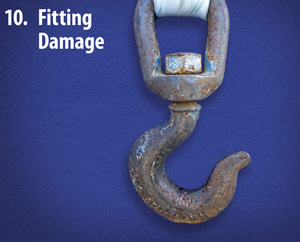 Any integrated hardware which displays deformation, pitting and severe
corrosion or significant metal loss. Refer to ASME B30.9, 10, and 26
for more specific criteria.
Any integrated hardware which displays deformation, pitting and severe
corrosion or significant metal loss. Refer to ASME B30.9, 10, and 26
for more specific criteria.
- 11. Illegible Identification
-
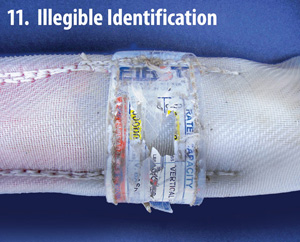 Missing data and/or information as required by identification requirements (see #1)
Missing data and/or information as required by identification requirements (see #1)
- 12. Impacted Particles
-
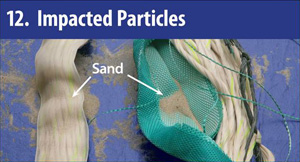 Impacted abrasive or sharp particles,such as sand or small metal shavings, permanently trapped inside the sling.
Impacted abrasive or sharp particles,such as sand or small metal shavings, permanently trapped inside the sling.
- 13. Other Conditions
-
 Conditions that may cause doubt as to the continued use of the sling may
include, but are not limited to crushed yarns, severe sling distortion,
unusual stiffness in the yarn and cover and broken stitching in the
cover splice.
Conditions that may cause doubt as to the continued use of the sling may
include, but are not limited to crushed yarns, severe sling distortion,
unusual stiffness in the yarn and cover and broken stitching in the
cover splice.
Care and Use of Synthetic Roundslings
- Protect slings from damage using abrasion or cut resistant/proof material of sufficient construction, strength and thickness as necessary.
- Slings can be damaged when contacting rough surfaces on the load, crane hooks or rigging hardware, and load edges.
- Store slings in a cool, dark and dry place to prevenet damage from chemicals, mechanical devices, extreme temperatures or ultraviolet light.
- Slings may not be repaired in the field, only by the manufacturer.
- Only connect the sling to hardware that allows proper seating based on size and shape.
- Synthetic slings shall not be used to support personnel nor as the dedicated rigging for a suspended personnel platform.
- Do not stand or pass under a suspended load.
- Personnel should not stand in-line with or next to a sling that is tensioned.
- No portion of the human body will come between the sling and load, and sling and hoisting hook.
- Know the weight of the load and ensure the sling(s) has sufficient rated capacity for handling the load in the prescribed rigging method and at the anticipated angle from horizontal.
- Do not expose slings to temperatures below -40°F (-40°C) or above 194°F (90°C) for polyester; or below -40°F (-40°C) or above 158°F (70°C) for high performance/HP yarns. The sling manufacturer should be consulted about exposing slings to temperatures beyond these ranges.
- Avoid shock loading slings, and do not land a load on the slings.
- Do not use slings for lifting when they are knotted or twisted.
- Rig the load so it is controlled, and avoid sling sliding while it is under tension.
- Prevent lose slings from snagging on obstructions.
- Carry or cart slings, and avoid dragging them over rough surfaces.
- When using choker hitches, do not choke on a fitting, and beware of capacity reduction due to the angle of choke.
- Prevent damage to the sling by not constructing, bunching or pinching the sling when it contacts the load, crane hook or fitting.
- The sling manufacturer should be consulted before slings are used in chemically active environments.
Notice: Become familiar with the instructions and regulations about the care, use and inspection of synthetic roundslings as addressed by Federal OSHA, State or Provincial requirements and ASME B30.9 SLINGS. Consult the inspectable roundsling manufacturer for additional guidance.
Inspectable Roundsling Removal Criteria Wall Poster available. Contact us to acquire one.
